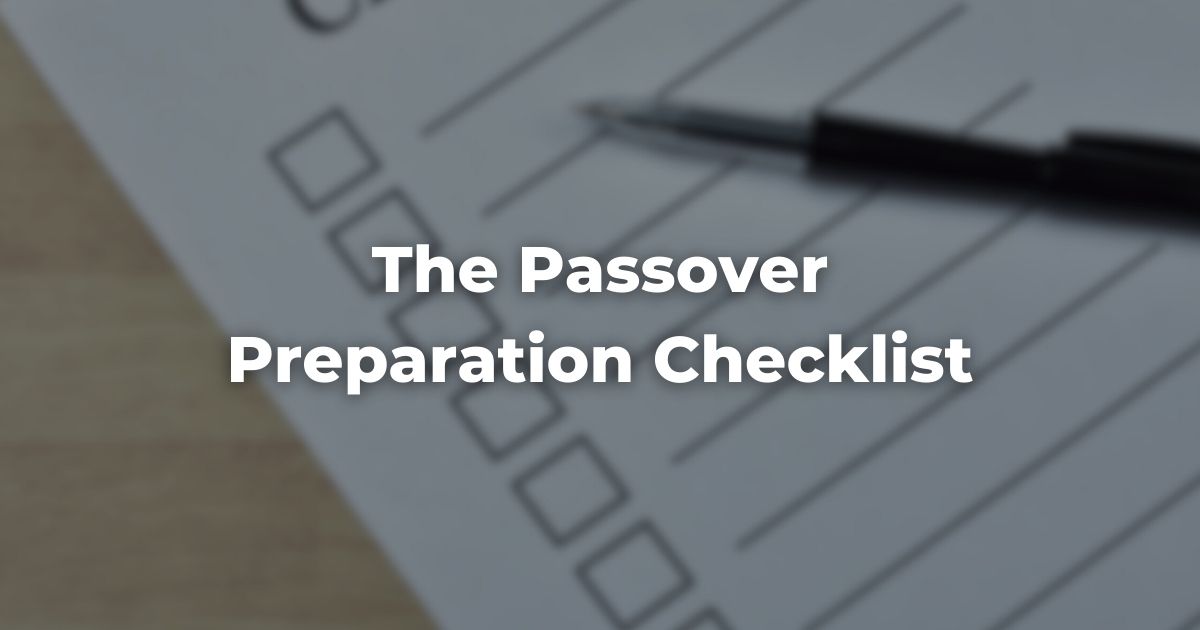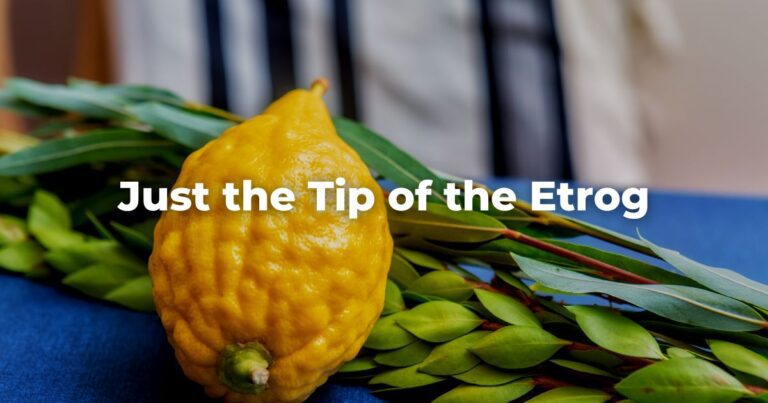How to prepare for Passover? What do you need to do to prepare for Passover?
Your 30-Day-ish (or less) Steps To Prepare for Passover
We know that preparing for Passover can feel like a daunting task. There are so many things to plan for! Food, utensils, guests! Don’t worry, because Exploring Judaism has your back!
With this handy checklist, you will be fully ready for Passover in no time! You can go through the list in order, one each day, or find the section by a particular part of the preparation process.
Table of Contents
You can download our Google Docs friendly checklist at the button below.
You can also sign up to get our five-day email series, which will walk you through each category of Passover preparation, making sure that you are ready to go!
Initial Preparations
🔲 Realize that Passover is only 30 days away.
The first step is to breathe. It will be ok. After that, you can begin by writing down your goals for your Passover experience (and Seder if you are hosting one). What kind of experience do you want to have?
🔲 Create a plan to consume perishable hametz items gradually.
Your kitchen is full of delicious foods, but not all of it will be kosher-for-Passover. Now is the best time to plan which foods you will eat and which will be stored and sold.
🔲 Reach out to your seder attendees.
Make a list of potential attendees and confirm the night and time for the seder and who will come. If you are not hosting a seder, you can check in with your hosts about what you can bring or how to help.
🔲 Start talking about Passover and the seder with your household.
This is a perfect time to start to talk about this with kids and get people excited about the foods, rituals, and activities that will happen.
🔲 Watch a movie or read something Passover related!
It doesn’t all have to be seder-related to get yourself in the mood. Maybe you’ll watch The Prince of Egypt or the classic 10 Commandments with Charlton Heston. Maybe you can review the story of the Exodus in the TorahRefers to the first five books of the Hebrew Bible, the Tanakh, also called the Five Books of Moses, Pentateuch or the Hebrew equivalent, Humash. This is also called the Written Torah. The term may also refer to teachings that expound on Jewish tradition. Read more itself.
🔲 Identify which Haggadah/ot you’re going to use.
The Rabbinical Assembly’s Feast of Freedom can be purchased here. You may want to order early to guarantee you have them on hand, but there are many wonderful Haggadot worth exploring. New ones are published every year.
Kitchen and Home Preparations
🔲 Identify where you are going to store your (to-be-sold) hametz.
It will be tough to avoid your hametz if it is mixed up with everything else. Finding a cabinet or room to store your hametz that is out of the way and won’t be seen during the holiday can be helpful.
🔲 Start cleaning and organizing living spaces.
While there will be time for a proper Passover cleaning, this is an excellent opportunity to do general cleaning around the house. Cleaning cabinets and clearing hametz will be easier if the house is in good shape. You might even find a lone Cheerio in a couch cushion!
🔲 Check your kitchen and storage for Passover-friendly utensils and dishware.
Some folks have utensils and dishware that are easily kashered for Passover, while others focus on an entirely different set of dishes. Take some time to inventory what you have, what you might want to switch, and what you want to store. To learn more about kashrut, you can click here.
Some folks will use paper plates, reusable and plastic silverware, or purchase inexpensive serving utensils rather than purchasing an entirely new set of dishes. That being said, we should always be conscious of our environmental impact and make thoughtful decisions.
Spiritual Reflecting
🔲 Begin to reflect on the meaning of Passover and personal liberation.
Read: Passover: An Invitation to Get Free
Read: The Four Children and Racial Justice
Read: Spiritually Cleaning the Hametz Within Our Souls
🔲 Take time to journal about your own “Egypt” and personal growth.
The word for Egypt in the Torah is Mitzrayim and is interpreted to be a combination of “min hatzarim” from the narrow places. We all experience these narrow places in our life. This is a great opportunity to reflect on those and how you might find an “exodus” from them.
🔲 Engage in acts of kindness and charity.
It says in the Haggadah, “Let all who are hungry, come and eat.” While this can be a powerful encouragement about who you invite to your seder, it is also a potent reminder that we can and should give tzedakah at this time. There are many wonderful ways to provide food and resources within your community. If you need help figuring out where to donate, ask your local rabbi.
🔲 Do some community learning.
See if your local community is hosting a Passover- or seder-themed study session. You can find local Conservative/Masorti communities here.
Seder Preparation
🔲 Download the Not a Haggadah Reader.
Exploring Judaism put together a special reader for 2024. You can download it here or purchase a physical copy here.
🔲 Confirm attendance and dietary restrictions with guests.
So you know how much food to make (or how much extra you want to have afterward), this is also a great time to consider allergies, alternatives to alcohol, and other such adjustments, depending on your guest list.
🔲 Plan your Passover menu.
Take time to review your favorite (or new) Passover recipes. Then, you can make an initial shopping list. If you want to be extra organized, plan the cooking schedule and “cook and freeze in advance” schedule.
If you’re going to cook in advance, be thoughtful about the kosher-for-Passover status of your kitchen. Don’t forget that Passover is eight days long! Make sure to plan for the rest of the week, too.
🔲 Think about the vibe you want to create for your seder.
Read: How to Make a Seder for Everyone
Read: Why is Diversity Important at the Passover Seder?
Read: Including non-Jewish guests at our Seder: A reflection
🔲 Begin collecting supplies for activities if you are hosting children.
Depending on the kind of experience you want for any children at your seder, it is a good time to collect the supplies you might need. Do you need little plastic jumping frogs? Do you need bingo boards?
Read: Tips For Passover with Toddlers
Read: Bringing Teens to the Seder Table
Read: When Can a Passover Seder Start Early?
🔲 Purchase or prepare Passover Seder plate items.
Make sure you have all of your seder place items. You will need the roasted shank bone (zeroa), egg (beitzah), your bitter herbs (maror), your apple or date chutney (haroset), your green vegetable (karpas). Some plates also include a spot for a bitter vegetable (hazeret). You can read more about those here. Don’t forget the matzah!
It is also a good time to check your Judaica and see if have what you need. Kiddush cups, a seder plate itself, cups for Elijah and Miriam.
Kashering and the Final Countdown
🔲 Make a Kashering plan.
Kashering can be a big task and it is important to set aside time to make a plan of how you’re going to do it.
Read: How to Kasher Your Kitchen: A Simplified Guide
Read: Rabbinical Assembly’s Pesah Guide
Read: Keeping a Kosher Kitchen
🔲 Consume any remaining perishable hametz and store the non-perishable hametz.
Now that we’re in the final stretch, it is time to finish eating all of that hametz and put the rest of it away. Some folks put it all in one cabinet and tape it shut, while others like to put it in a room. If you plan on taking the hametz to the house of the person who is buying it, keep that in mind too.
🔲 Review the Haggadah and create a seder plan (and your readers).
It is generally a good idea to read through the Haggadah or additional materials and plan how you expect your seder to go, even if it ends up different than you expect. Think about who might be a good fit for each section. Don’t forget, we want people to ask good questions! A great conversation is well worth getting “off track.”
Now is a great time to assign parts or responsibilities to your guests so they have time to plan and mentally prepare themselves for reading in public. If you have particular songs you like, you can usually find a version of it online, you can send those to your guests as a refresher.
You can check out our Not a Haggadah Passover Reader if you want to add additional readings and reflections.
🔲 Make a plan for the seder table, seating, and other space-related concerns.
Depending on your space, you may want to figure how where you are going to do the seder. Will you all be sitting at the table? Will you be sitting on couches or with pillows? Take some time to think through the logistics of your seder experience.
🔲 Begin the first day of cleaning and kashering.
Depending on the size of your kitchen, how much you’re kashering, and what kind of heads up you like to give yourself, this can be a two-day process. It might be good to complete the kashering a few days before Passover, so you have plenty of time to cook without getting stressed.
To kasher something, it needs to have been cleaned and unused for a day. Setting aside two days might be useful.
Read: How to Kasher Your Kitchen: A Simplified Guide
Read: Rabbinical Assembly’s Pesah Guide
Read: Keeping a Kosher Kitchen
🔲 Continue with the second day of deep cleaning and kashering.
With everything cleaned and ready to go, you can ensure your utensils and surfacers are prepared for Passover. It can be good to start this process early in the day since it can be a bit of a start-and-stop process of waiting for things to boil or heat up.
🔲 Prepare non-perishable Passover dishes in advance.
If you already have a plan for what food you’ll make, and if your kitchen is already kashered, it is an excellent idea to make some of the dishes in advance so you don’t have to rush. Putting pre-prepared meals that you can just take out of the freezer will make your week of Passover much easier.
🔲 Sell your hametz.
We recommend contacting your local congregation and rabbi to facilitate this process. You can do this via the Congregation Finder here. While you are at it, it is also a great time to Identify when the last hametz can be eaten and plan for lunch tomorrow. Confirm the timing with your local rabbi.
🔲 The night before Passover, participate in bedikat hametz.
On the night before Passover begins (the night before the first seder), there is a custom to inspect your house for hametz using a feather and a spoon. This can be a powerful ritual and a fun one to do with children. You can check out our one-pager here.
🔲 Final preparations and cooking for your seder!
You made it! Your seder is about to begin, and you are finished.
Author
-

Exploring Judaism is the digital home for Conservative/Masorti Judaism, embracing the beauty and complexity of Judaism, and our personal search for meaning, learning, and connecting. Our goal is to create content based on three core framing: Meaning-Making (Why?), Practical Living (How?), and Explainers (What?).
View all posts





